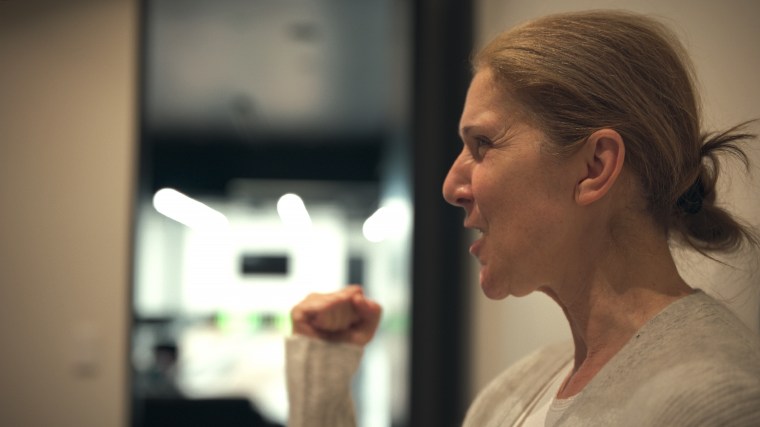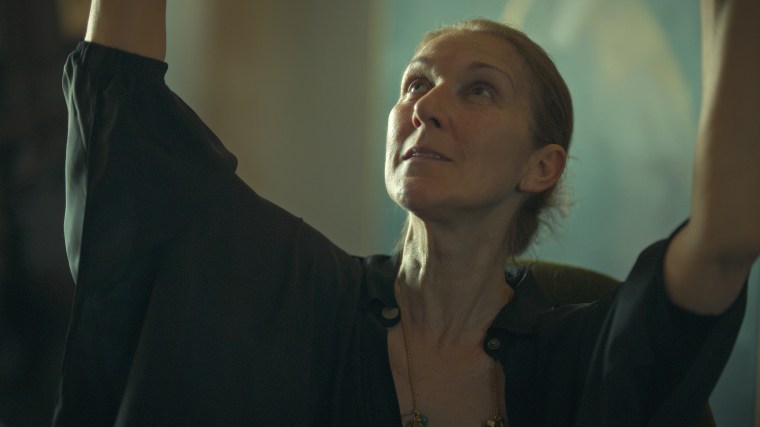Céline Dion Suffers Medical Crisis In Documentary: Her Doctor ...
Céline Dion has been living with symptoms of stiff person syndrome for 17 years, she reveals in a new documentary detailing her life with the condition, "I Am: Céline Dion," out on Prime Video June 25. One especially harrowing scene at the end of the film gives an up-close look at the more severe effects the autoimmune and neurological illness, which causes muscle stiffness and painful spasms.

In the scene, Dion is having a physical therapy session shortly after viewers see her recording a new song, "Love Again." She's going through what appear to be standard exercises with her physical therapist, part of her treatment efforts to improve her health and hopefully perform again.
Céline Dion in the documentary, "I Am: Céline Dion."Amazon MGM StudiosThen, she starts to experience cramping in one of her feet, and within minutes, her whole body is tensed up to the point where she cannot speak, move or even change her facial expression, which is contorted in pain.
Céline Dion suffers medical crisis in documentaryThe spasm that turned into a crisis was her first that day, Dion explains in the film. Her physical therapist speculates that she was "overstimulated." He turns her onto her side on a massage table as all her limbs twitch and her fingers are stuck extended at awkward angles. Her lip then starts twitching too.
A member of her team asks her to squeeze his hand if she can hear him. She remains motionless and curled up, but finds a way to show him that she’s aware of what’s happening to and around her. "She's still with us," her physical therapist says.
As the crisis continues, Dion's face glistens with silent tears, and she wails in pain. In the scene, she receives benzodiazepine nasal spray, her physician Dr. Amanda Piquet, director of the autoimmune neurology program at the University of Colorado School of Medicine Anschutz Medical Campus, tells TODAY.com. It is part of a class of depressant drugs that relieve anxiety and reduce muscle spasms.
The spasms seem to last between 30 minutes and an hour, as her team watches, concerned. Eventually her muscles calm down enough that she's able to sit up and speak again.
"Every time something like this happens, it makes me feel so embarrassed," Dion says in the aftermath. "I don't know how to express it, you know, to not have control over yourself."
Her PT then theorizes that her excitement from singing earlier may've played a role in the stiff person syndrome attack. The music legend wonders aloud how she'll ever be able to perform again if an intimate recording session can bring on a medical crisis.
"If I can't get stimulated by what I love, then I'm going to go on stage, and you're going to put the pulse oximeter on me and turn me on my back?" she says.
"It's scary, I know," her PT replies. "It's hard. This is not the end of your journey."
The film's director, Irene Taylor, recalled what it was like to witness this scene in a recent interview with TODAY's Hoda Kotb. "It was the most extraordinarily uncomfortable moment in my life, as a filmmaker but also as a mother, as a fellow human, because I didn’t know what was happening," Taylor said.

"I had this uncertainty whether to keep filming or not. But (Céline) gave me the strength to just keep going. We had been filming together for many months at that point, so she had really trained me, 'Just keep going. If I have to stop you, I’ll stop you.'"
"Her body was enduring something that was unimaginable, and I wasn’t sure if she was aware of it," Taylor continued. "I wasn’t sure if she was going to survive it. It’s really hard to even sit next to her and talk out loud about it because it was very intense."
Amazon MGM StudiosDion replied, "I just want you to know that you did the right thing. I’m sorry that it was hard."
Reflecting on her severe stiff person syndrome episodes, Dion told Hoda that she used to "lose it for two hours without knowing." When she first started getting them, she would tell herself, "OK, it's going to be fine. (But) then you have a hard time to walk, and then you blank for two hours, and you’re like, what happened?"What is a stiff person syndrome attack?Many patients with stiff person syndrome experience muscle cramping, spasms and stiffness constantly, but certain movements or emotions can trigger "a complete, whole-body spasm," Piquet, who is a member of the advisory board of the Stiff Person Syndrome Research Foundation, explains.
Recalling the scene with Dion's full-body spasm, which started in her foot, Piquet says, "That anxiety, that panic, that continued spasm that was not breaking then very quickly triggered just a complete whole body spasm.”
"It's not a seizure," Piquet clarifies. "This is a spasm that is occurring, and patients are aware of what's going on. There's a lot of anxiety, there's a lot of panic, your adrenaline's rushing."
David Axelrod, 36, of Milford, Connecticut, has experienced similar episodes due to his stiff person syndrome.
"On the minor side of a severe spasm is, for example, if I yawn too large, or if I'm chewing in a weird way, my entire neck and throat will go into spasm, and the muscle just bulges out, and my jaw gets locked open in place, and I just kind of have to breathe through it, throw some heat on it and try to get it to calm down," he explains.
But "the worst type," he says, is a spasm that extends from his rib cage to his abdomen and through his back. "I turn into a sheet of solid muscle, and you can even see the individual muscles spasming. ... It causes my back to arch up, and that leads to spasming in my back, my legs and my arms as well. So it's essentially a full-body spasm. I can't move, and it can sometimes last up to a few hours."
"If I’m lucky and somebody’s nearby, they can get me a hot pack, and I put the hot pack and pressure on it and that can help relieve it," Axelrod adds. "Sometimes it happens when I'm by myself, and I can't get up, I can't move, I just have to lie there."
He describes the pain as "a charley horse times 100. Sometimes you can barely breathe." And the mental load is also overwhelming.
"(You're thinking), 'Oh no, oh no, oh dear God, please don't let this happen,'" Axelrod says. "It's a panic-stricken moment. It's not a fun experience to go through that. But I've definitely found trying to remain calm and deep-breathing through it does have a positive effect on it."
These kinds of episodes are more common in patients who do not have their symptoms controlled, according to Piquet. Axelrod adds that he's more likely to experience one when he's got other stressors in his life. During a previous job, he had them multiple times a week.
What has Céline Dion said about her recovery?According to Piquet, Dion has made "significant progress" in managing her symptoms since the documentary was filmed. Dion shared in the film that her treatment regimen involves physical therapy, intravenous immunoglobulin (which helps with the autoimmune aspect of stiff person syndrome) and muscle relaxers.
She's shared that she's eager to get back on stage soon, though she doesn't have a specific date yet. Dion has said it's possible that when she returns she will have to cancel shows to prioritize her health, but she's still maintaining a positive outlook.
"I have to trust myself. I have to trust my team. I have to trust my voice. I have lived tough things, but we all do," she told Hoda. "But lots of joy as well. I’m about to live a lot of happiness."
Maura Hohman
Maura Hohman is the senior health editor for TODAY.com and has been covering health and wellness since 2015.









































